Preparation and Photocatalytic Activity of Co: La: Tio2 Nanocomposites for the Degradation of Methyl Blue in Visible Light
Azad Kumar* and Gajanan Pandey
Department of Applied Chemistry, Babasaheb Bhimrao Ambedkar University, India
Submission: August 22, 2017; Published: September 12, 2017
*Corresponding author: Azad Kumar, Department of Applied Chemistry, School for physical education, Babasaheb Bhimrao Ambedkar University, Lucknow-226025, Email: kumarazad20@gmail.com
How to cite this article: Azad K, Gajanan P. Preparation and Photocatalytic Activity of Co: La: Tio2 Nanocomposites for the Degradation of Methyl Blue in Visible Light. JOJ Material Sci. 2017; 2(5): 555596. DOI:10.19080/JOJMS.2017.02.555596
Abstract
In this study, prepared the nano composites of Co: La:Tio2 by the wet chemical method. Synthesized Tio2 and Co:La:Tio2 were characterized by X-Ray Diffractometer, SEM,TEM, UV-vis, FT-IR, Band gap energy and BET. The Tio2 and Co:La:Tio2 were used as photocatalyst for the degradation of Methyl Blue. The XRD pattern confirmed the presence of anatase and rutile phase in the catalyst. The particle size was estimated by the Scherrer’s and found 68 and 32nm for Tio2 and Co: La: Tio2 respectively. The particle morphology of the photocatalysts was found in nanodiamension. The surface area of the photocatalysts were found 37.52 and 106.68m2/g for Tio2 and Co: La.Tio2 respectively. The band gap energy of Tio2 and Co: La.Tio2 were 3.2 and 3.0eV. The photo degradation of Methyl Blue has been found maximum at 5pH, 25ppm concentration of dye, 800mg/L amount of photo catalyst and 180min illumination of visible light. The photo degradation was following the first order kinetics.
Keywords: Photodegradation; Photocatalyst; Photocatalysis; Methyl blue; Nanocomposite
Introduction
Dyes are the most resistant compounds that are found in industrial waste water causing adverse environmental problems. Most of the dyes used in the pigmentation of textiles, leather, paper, ceramics, and food-processing are derived from azo dyes. Dyes are lost with waste water during synthesis and processing [1-5]. This represents a great hazard to human and environmental health due to the toxicity of azo dyes [6]. The treatment of such pollutants can be achieved by heterogeneous photo catalysis due to its efficiency and low cost as well as to the fact that it allows complete degradation of pollutants to carbon dioxide and inorganic acids [7-9].
Titanium dioxide Tio2 is a most important nanomaterial which has attracted a great attention due to its unique properties. Titanium dioxide Tio2 have excellent merits in solar energy transferring and photocatalysis of poison compounds in environment. The chemical inertness and the non-toxicity of Tio2 have also made it a superior photocatalyst [10-13]. Titania has a large band gap (3.20ev for anatase Tio2) and therefore, only a small fraction of solar light can be absorbed [14]. Many attempts have been made to sensitize titanium dioxide to the whole visible region, such as doping with transition metals [15-16], transition metal ions [17], non-metal atoms [18] and organic materials [19]. Introduction of dopant allows Titania to absorb in the visible region but this does not necessarily mean that the doped catalyst has a better photocatalytic activity (Figure 1).
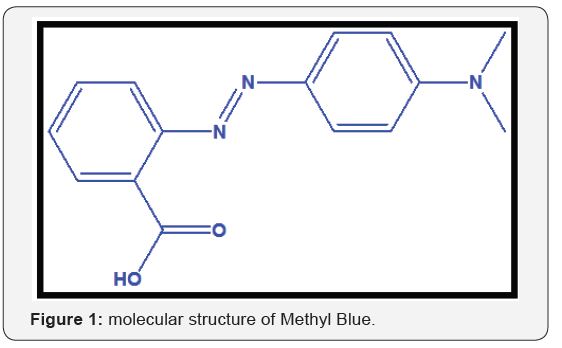
In photocatalysis, light is absorbed by an adsorbed substrate. Today, semiconductors are usually selected as photocatalysts, because semiconductors have a narrow gap between the valence and conduction bands. In order for photocatalysis to proceed, the semiconductors need to absorbed energy equal to or more than its energy gap. When Tio2 is irradiated by UV light (400nm or less), electron is excited to generate electron (e_) hole (h+) pairs.This movement of electrons forms e-/h+ or negatively charged electron/positively charged whole pairs. The hole can oxidize donor molecules. In photo generated catalysis the Photocatalytic Activity (PCA) depends on the ability of the catalyst to create electron-hole pairs, which generate free radicals able to undergo secondary reactions [20-24].
Methodology
Synthesis of titania by wet chemical method

Synthesis of Co:La:Tio2 nanocomposite
In this method, 10ml of TiCl4 solution (1000mg/l), 2ml of 0.1M Cobalt acetate, 1ml of 0.1M Lanthanum nitrate and NaOH solution (64.5g/l) was added drop wise to water with stirring. After the resulting solution reaches pH to 7, the slurry was filtered, and the filter cake of Tio2 was washed and redispersed in water to prepare 1M of Tio2 slurry. Resulting Tio2 slurry and an aqueous solution of HNO3 were refluxed at 95 °C for 2h, cooled to room temperature and neutralized with 28% of aqueous ammonia. Then, it was filtered, washed and calcined at 400 °C [25,26].
In this study, Co:La:Tio2 nanocomposites was prepared by solution impregnation method. In this method suitable quantity of prepared Tio2 (2g) was dispersed in alcoholic cobalt acetate 10% (w/v) and lanthanum nitrate 5% (w/v). The dispersion is agitated continuously for 4 hour at 80 °C temperature. After the treatment the residue was removed through filtration and was sintered for 4hour in presence of air at 600 °C by kipping it in a silica crucible inside the muffle furnace. After sintering and slow anilling to room temperature, content was taken out from furnace and was stored in air tight bottles and was used as photocatalyst [27].

Characterization
The physical properties of metal oxide semiconductor nanocomposites that may influence significantly their use as photocatalyst are dependent on nature of crystalline phase present. Thus, phase analysis is an important parameter for this study and the prepared samples were subjected to x-ray diffraction analysis on Powder X-Ray Diffractometer. The observed X-Ray diffractogram of samples were analyzed further to estimate average grain size in the sample by Scherrer’s calculation. Since the absorption of light by photocatalyst is the most crucial step in any photocatalysed reaction, and is decided primarily by the band gap energy of material. The morphology and size of the Titania particles were analyzed by Scanning Electron Microscopy (SEM) and Transmission Electron Microscopy (TEM).
Photo-degradation of dyes
In this study by the photo-catalytic degradation of Methyl Blue was investigated. A solution of dye in water: alcohol (10:1V/V) was prepared and in this solution a suitable quantity of photocatalyst (100 to 800mg/L) was dispersed. The dispersion was subjected to Visible light irradiation for varying duration and after desired irradiation the residual concentration of dye in the solution was determine spectrophotometrically by taken out suitable aliquot of dispersion and removal of photocatalyst by centrifugation. For quantitative estimation of dye concentration, initially calibration curve was obtained and it was utilized to measure the concentration in different sample aliquot obtained at different time. A quantitative estimation of dye concentration spectrometric observation when recorded only at the experimental determines λ max value which is 670nm [28-30].
Results
Phase identification by X-ray diffraction analysis
The obtained X-Ray diffraction patterns of Titania and Co:La:Tio2 are shown in Figures 2a & 2b. The observed pattern of peaks, when compared with the standard JCPDS database, suggested that, in prepared Tio2 sample, major peaks at 2θ=25.5° 37.2, 48.3, and 54.4, which can be indexed to the (101), (004), (200), and (211) crystal facets of anatase Tio2 (JCPDS File number: 21-1272). Whereas major peaks at 2θ=26.9° and 28.2° indicate the presence of rutile phase which can indexed to the (110), (121), respectively. In case of Co:La:Tio2 sample, the observed XRD pattern indicates not only a change in the peak intensity, compared to Tio2, but even the absence of some originally observed Tio2 peaks [31]. This is, probably, due to the change in the crystallinity and grain fragmentation, when the samples were wet impregnated by cobalt and Lanthanum.
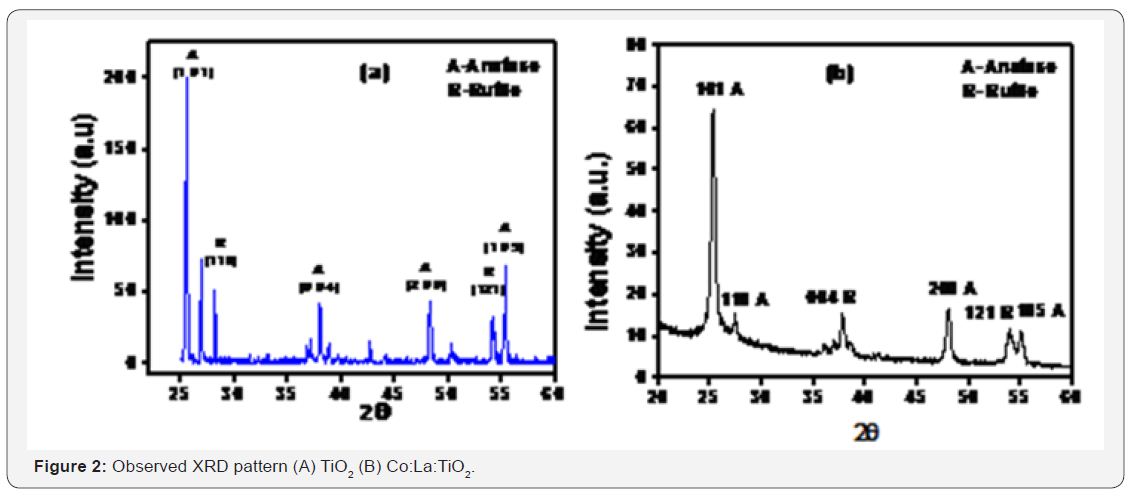
Determination of crystalline size of samples
The Scherrer’s calculations were attempted to know the average size of particles/grains in the samples [32]. Although, Scherrer’s calculations are only approximate in nature, but definitely provide a first-hand idea of the Crystalline size of samples, which may be quite accurate, provided the size of crystal is below 100nm. The results of Scherrer’s calculations are presented in Table 1. The results suggest Crystal size in the samples lying in nm range.

Scanning electron microscopy (SEM)
The morphology of the samples was investigated by scanning electron microscopy and it resumes the most interesting outcomes. 3(a) and 3(b) clearly show that both the prepared samples are obtained in nanometric dimension. The doping of cobalt and lanthanum is indicating that the particle size reduce due the penetration of cobalt and lanthanum in the lattice of titanium dioxide [33] (Figure 3).
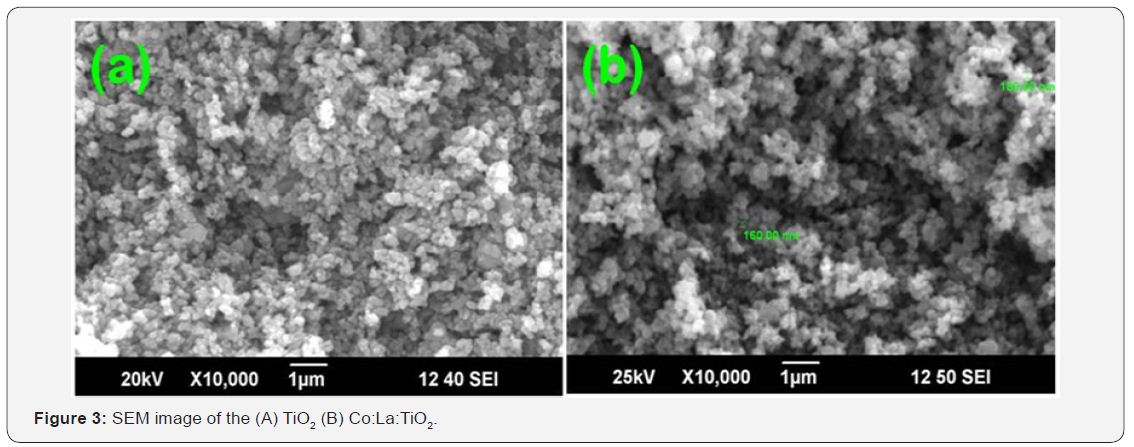
Transmission electron microscope (TEM)
TEM images were clearly displayed the morphology and particle size of neat Tio2 and Cobalt and lanthanum doped Tio2. From the Figure 4 we find that Cobalt and lanthanum doped modified Tio2 change the size of neat Tio2 significantly, as shown in Figure 4(a) & (b). The sizes of both modified and neat Tio2 are mono disperse about 100-200nm. Moreover, the crystal lattice line can be clearly found in the TEM images. The aggregations of both kinds of particles are caused by high surface energy; however, the agglomeration of the modified one is alleviated obviously compared with that of the neat [34].
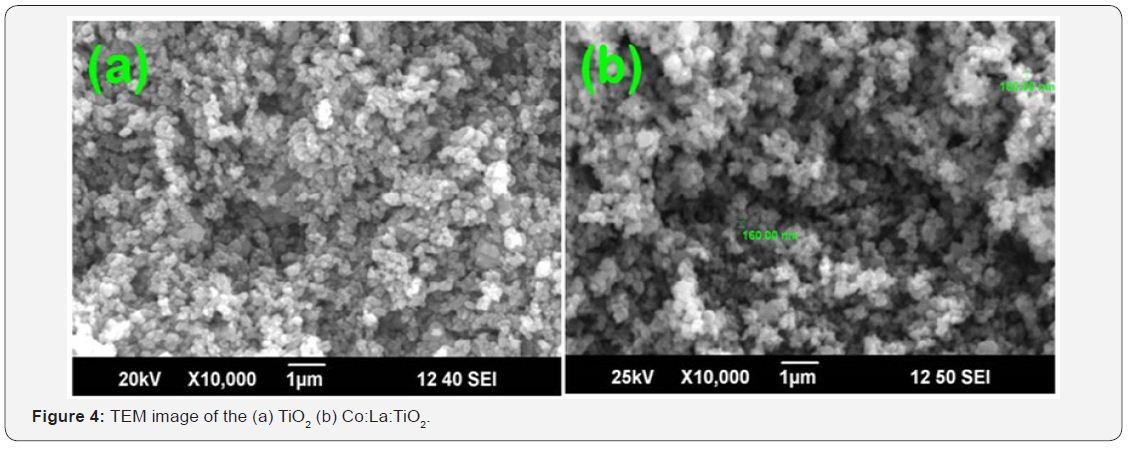
Surface Area Analysis (BET)
Figure 5 shown the BET and adsorption and desorption plot for the Tio2 and Co:La:Tio2. With the help of Figure 6 we can determine the specific surface area, pore volume and average pore size of the Tio2 and Co:La:Tio2 photocatalyst. Table 2 shown the physical properties of Tio2 and Co:La:Tio2. The Tio2 modified by Cobalt and Lanthanum are fragmentation to some extent during thermal treatment, leading to a marked increase of the BET surface areas and the average pore radius size and decreasing of the pore volume [35,36].
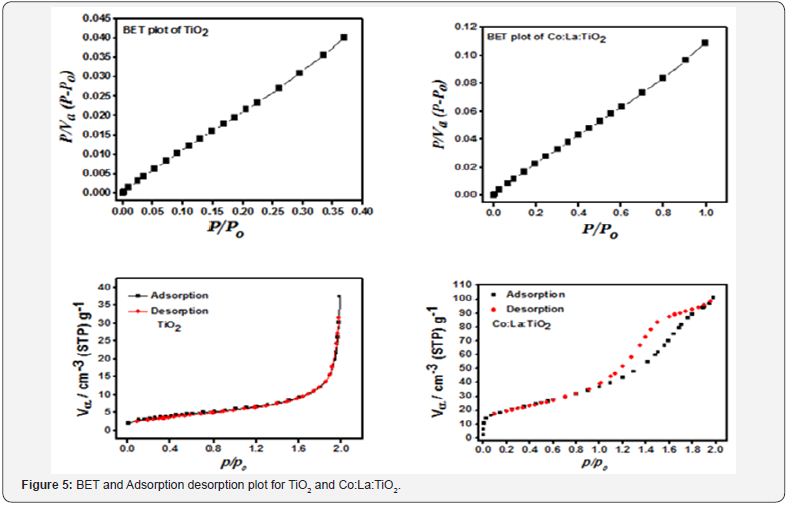
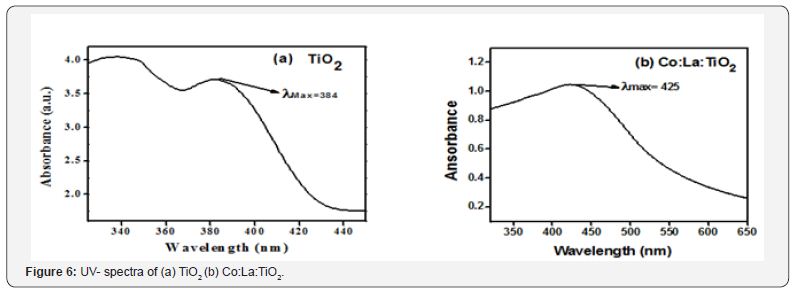

UV-Vis spectra
Aqueous suspensions solution of the photocatalysts was used for the UV absorption studies. The absorption spectrum of Tio2 consists of a single broad intense absorption at 384nm due to the charge-transfer from the valence band to the conduction band [37]. The undoped Tio2 showed absorbance in the shorter wavelength region while Co:La:Tio2 result showed a broad peak at 425nm in the higher wavelength (Figure 7). The impregnation of Co and La ions into Tio2 could shift optical absorption edge from UV to visible range, but prominent change in Tio2 band gap was observed [38].
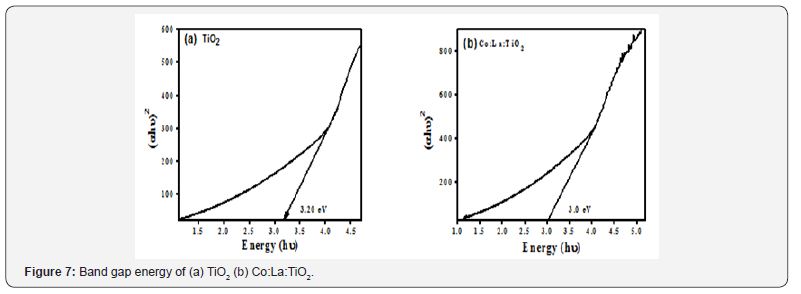
Band gap energy determination
The band gap of samples was calculated by extrapolation of the (αhv)2 versus hv plots, where α is the absorption coefficient and hv is the photon energy, hv=(1239/λ) eV. The value of hv extrapolated to α = 0 gives an absorption energy, which corresponds to a band gap (Eg). Figure 8 yields an Eg value of 3.2eV for Tio2 and 3.0 for Co:La:Tio2 [39]. The slight decrease in band gap energy in case of Co:La:Tio2, is due to formation of subband level between valence band and conduction band caused impregnation of Co+2 and La+3 in Tio2 host.
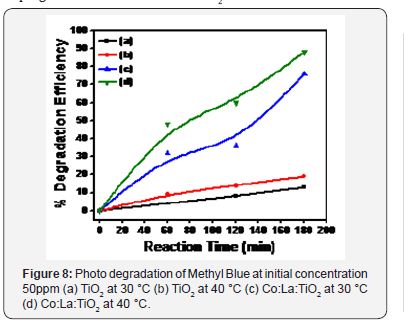
Photo-degradation of Dyes
The photo-catalytic degradation of Methyl Blue in the presence of Tio2 and Co:La:Tio2 has been studied. The solution of dye was prepared in 10:1 (V/V) ratio of water and alcohol. The known amount of photocatalyst 800mg/L was dispersed in the dye solution. The reaction mixture was illuminated under visible light, while kept continuously under agitation, for the different time intervals and different temperature. The residual concentration of dye in the reaction mixture was measured spectrophotometrically. The results obtained for the degradation of Methyl Blue is shown in Figure 9-11.
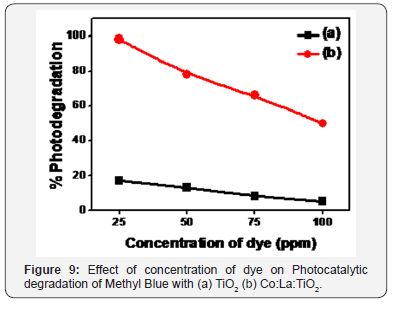
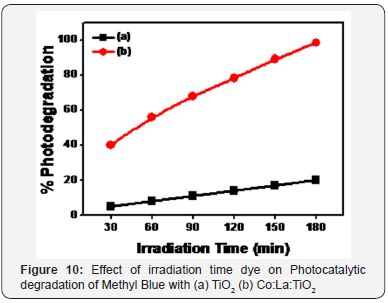
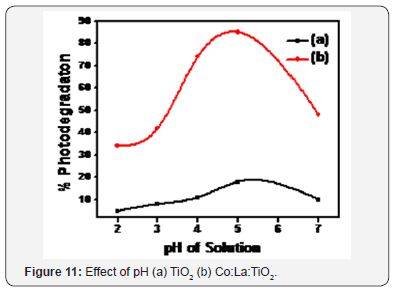
Effect of temperature: The effect of system temperature on photocatalysis has not attracted enough attention. But In present research, it is found that the temperature has a great effect on the photodegradation of Methyl Blue. The photocatalytic efficiency can be increased about 2-3 times if the temperature increased from 30 °C to 40 °C Because the solar energy include UV light, which can be used to activate the photocatalytic course, which is increase the temperature of photocatalytic system. The experiments showed that Methyl Blue were photodegraded in presence of photocatalyst and Visible light. The Methyl Blue was efficiently degraded shown in Figure 9. The obvious decrease of concentration of dye shows that the Tio2 and Co:La:Tio2 can serve as an effective photocatalyst [40].
Effect of concentration of dye: Effect of dye concentration Keeping the catalyst loading concentration constant at 800g/ liter of the dye solution, the effect of varying concentration of the dye was studied on its rate of degradation (from 25ppm to 100ppm) as given in Figure 10. With increasing concentration of Methyl Blue the rate of degradation was found to decrease. This is because as the number of dye molecules increase, the amount of light (quantum of photons) penetrating the dye solution to reach the catalyst surface is reduced owing to the hindrance in the path of light. Thereby the formation of the reactive hydroxyl and superoxide radicals is also simultaneously reduced. Thus there should be an optimum value maintained for the catalyst and the dye concentration, wherein maximum efficiency of degradation can be achieved [41].
Effect of irradiation time on photodegradation: The effect of irradiation time on the photodegradation of methyl blue has been studied in presence of Tio2 and Co:La:Tio2. The photodegradation of methyl blue was increased with increase irradiation time. The photodegradation was found maximum in case of Co:La:Tio2 for 180min irradiation of visible light. Fig.11 shows the effect of irradiation time on photocatalytic degradation of methyl blue. This is due to the interaction of dye molecule with the surface of photocatalyst as well as the time of irradiation increase the interaction increased. Therefore the photodegradation efficiency of photocatalyst was increased.
Effect of pH of solution: The photodegradation reaction was also carried out under varying ph conditions from (2 to 9), by adjusting with H2 SO4 and NaOH, with Tio2 kept at constant amounts of 800mg/ L of dye solutions (Figure 12). The reaction was found to have low rates at acidic ranges of pH. While at pH 5 photodegradation was found maximum. This implies that less acidic conditions are favourable towards the formation of the reactive intermediates that is hydroxyl radicals is significantly enhanced, which further help in enhancing the reaction rate. On the other hand in highly acidic medium conditions for the formation of reactive intermediates is relatively less favorable and hence less spontaneous [42].
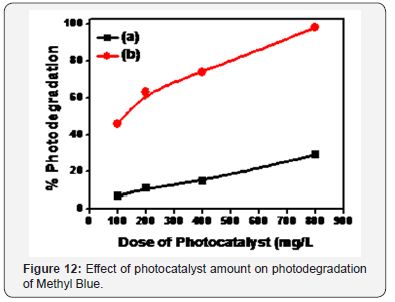
Effect of photocatalyst amount: The effect of photocatalyst amount has been studied by applying the different amount (100ppm to 800ppm) of the photocatalyst. The photodegradation rate was found to increase by increasing the amount of photocatalyst. It is clear from the results shown in Fig.13, the photodegradation increased rapidly with increase of amount of Co:La:Tio2. This is due to the fact that introduction of Co2+ and La+3 the band gap energy decreased up to 3.0eV which enhance the photocatalytic activity [43].
Effect of photocatalyst: It is clear from the results shown in Figure 9-12 that both Tio2 and Co:La:Tio2 are effective photocatalyst for the degradation of Methyl Blue (MB) dye. However Co:La:Tio2 seems to be more effective as photo-catalyst for the degradation of Methyl Blue (MB). The prominent degradation of Methyl Blue was found in 3 hour study in the presence of Co:La:iO2 in comparison to the prepared Tio2 [44] (Figure 13).
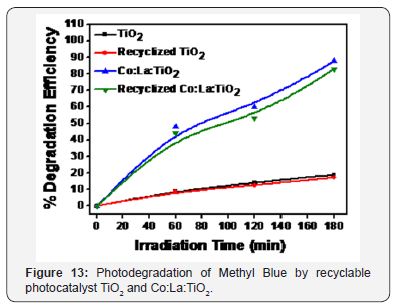
Recyclability of photocatalyst
The photocatalyst and Methyl Blue mixture was agitated, illuminated with visible light and after desired time, the mixture was centrifuge to remove the photocatalyst. The obtained photocatalyst was washed three times with distilled water and kept in oven for 24h at 60 °C and reused for the degradation of Methyl Blue. The photodegradation of Methyl Blue by the recyclized Photocatalyst are showing in Figure 14. The result shows that the recyclized photocatalyst efficiency is slightly decreased probably due to the loss of some active sites and decrease of collection efficiency of photon [45].
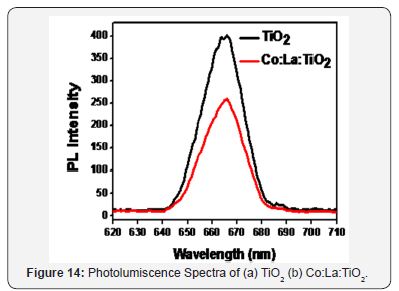
Stability of composite photocatalyst: Some kinds of experiments were carried out to confirm the photostability of polyaniline modified Tio2 photocatalysts. The FT-IR spectra of PANI-modified Tio2 particles before and after reaction were recorded as shown in Figure 9. It is found that the shape of composite IR spectrum after photocatalytic experiment is similar to that of particles before experiment. It indicates that the structure of PANI-modified Tio2 does not change during the photo catalytic process. The PANI is very stable and is not chemically transformed to other organic compounds. It has been confirmed that the PANI-modified Tio2 shows good stability under irradiation conditions and they continue to maintain perfect photocatalytic activity also after several cycles (Figure 10). A slight decrease of photoactivity after each cycle is due to slight aggregation of nanoparticles during the catalytic process.
Lowering of electron-hole recombination
Photoluminescence spectra have been used to examine the mobility of the charge carriers to the surface as well as the recombination process involved by the electron-hole pairs in semiconductor particles. PL emission results from the radiative recombination of excited electrons and holes. In other words, it is a critical necessity of a good photocatalyst to have minimum electron-hole recombination. To study the recombination of charge carriers, PL studies of synthesized materials have been undertaken. PL emission intensity is directly related to recombination of excited electrons and holes. Figure 15 shows the photoluminescence spectra of synthesized photocatalysts. In the PL spectra the intensity of Tio2 is higher than Co:La:Tio2 indicating rate of recombination of e-- h+ is higher in Tio2 than that of Co:La:Tio2.The weak PL intensity of Co:La:Tio2 may arise due to the impregnation of Ni in Titania lattice, which for sub band level in band gap region of Tio2. This delays the electronsholes recombination process and hence utilized in the redox, reaction leading to improved photocatalytic activity [46].
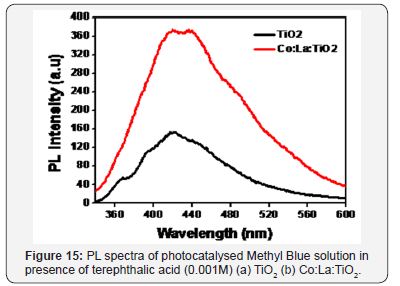
Hydroxyl radical formation
As hydroxyl radical performs the key role for the decomposition of the organic pollutants, it is necessary to investigate the amount of hydroxyl radicals produced by each photocatalyst. In this study Terephthalic Acid (TA) has been used as a probe reagent to evaluate •OH radical present in the photoreaction pathway. Figure 16 shows the PL spectra of Tio2and Co:La:Tio2 recorded Methyl Blue solution in presence of 10- 3M Terephthalic solution. OH radical attack Terephthalic, forming 2-hydroxyl Terephthalic Acid (TAOH) which gives a fluorescence signal at 426nm. The fluorescent intensity is linearly related to the number of hydroxyl radicals formed by the photocatalysts. Higher the generation of hydroxyl radical, more will be yield of TAOH and hence more intense will be the fluorescence peak. The spectra show that the intensity of peak indicating in presence of Co:La:Tio2 higher generation of more number of hydroxyl radicals compared to Tio2 [47].
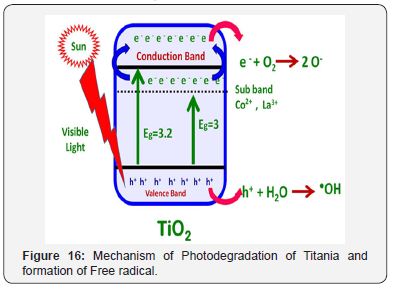
Mechanism of photooxidation process
The photocatalytic mechanism is initiated by the absorption of the photon hv with energy equal to or greater than the band gap of Tio2 (3.3eV for the anatase phase) producing an electron hole pair on the surface of Tio2 nanoparticles. An electron is promoted to the Conduction Band (CB) while a positive hole is formed in the Valence Band (VB). Excited state electrons and holes can recombine and dissipate the input energy as heat, get trapped in meta stable surface states, or react with electron donors and electron acceptors adsorbed on the semiconductor surface or within the surrounding electrical double layer of the charged particles. After the reaction with water, these holes can produce hydroxyl radicals with high redox oxidizing potential [48-50]. Depending upon the exact conditions, the holes, OH radicals, O2, H2O2 and O2 itself, When the semiconductor is illuminated with light (hυ) of greater energy than that of the band gap, an electron is promoted from the VB to the CB leaving a positive hole (h+) in the valence band and an electron (e-) in the conduction band as illustrated in Figure 17.
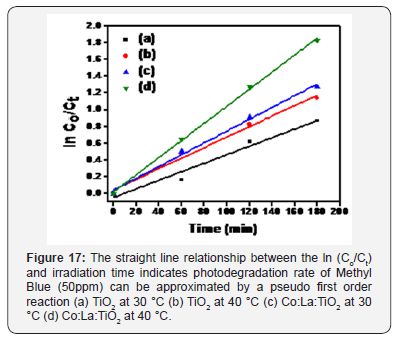
If charge separation is maintained, the electron and hole may migrate to the catalyst surface where they participate in redox reactions with sorbed species. Specialy, h+vb may react with surface-bound H2O or OH- to produce the hydroxyl radical and ecb- is picked up by oxygen to generate superoxide radical anion (O2-), as indicated in the following equations 6-8;
Absorption of efficient photons by titania (hυ ≥ Ebg = 3.2ev)
Tio2+ hυ → ecb + h+vb (6)
Formation of superoxide radical anion
O2 + ecb → O2- (7)
Neutralization of OH- group into OH by the hole
(H2O ⇔ H+ + OH-)ads + h+vb → •OH + H+ (8)
It has been suggested that the hydroxyl radical (•OH) and superoxide radical anions (O2 - ) are the primary oxidizing species in the photocatalytic oxidation processes. These oxidative reactions would results in the degradation of the pollutants as shown in the following equations 9-10;
Oxidation of the organic pollutants via successive attack by OH radicals
R + •OH → R. + H2O (9)
or by direct reaction with holes
R + h+ → R+ → degradation products (10)
Kinetic study
The pseudo-first-order rate constant (k, min-1) for the photodegradation reaction of Methyl Blue was determined through the following relation where, k can be calculated from the plot of ln (Co/Ct) against time (t), Co and Ct denote the initial concentration and reaction concentration, respectively.
ln Co/Ct =k1 t……………………………………..……………1
In addition, the linear feature of plots of ln(Co/Ct) versus time (Figure 18) indicates that this photocatalytic degradation reactions follow the pseudo-first-order rate law [51-54]. The rate constant of the photocatalysis at 30 °C is 0.04260 to 0.0234min- 1. The effect of temperature and concentration are showing in Table 3.
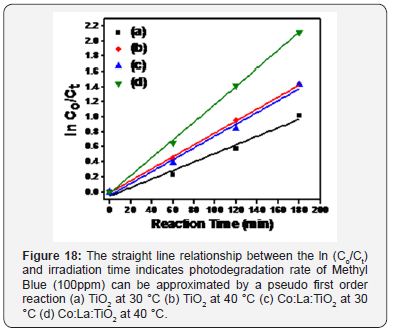

Thermodynamic parameter study
In this section an attempt has been made to calculate different activation parameters. For this the reaction has been studied at two different temperatures and with the help of observed rate / rate constant, the energy of activation (DE*), specific rate constant (kr), entropy of activation (DS*), enthalpy of activation (DH*), free energy of activation (DG*) and Arrhenius frequency factor (A) have been computed for different reactions (Table 4) [55]. The activation parameters have been calculated with the help of following equations.
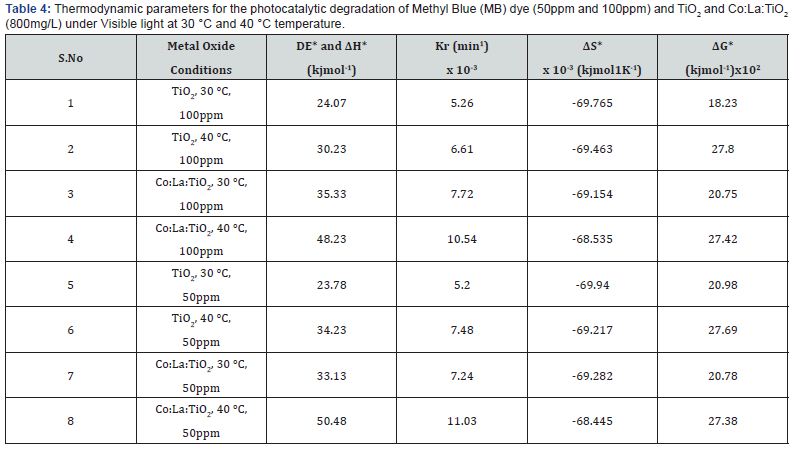
DE* = value of slope x 2.303R
log A = Log kr (at 35 °C ) + Ea /2.303RT
ΔS* = 2.303 R(log A-13)
ΔG* = Ea - TΔS*
ΔH*=ΔG* + TΔS*
The calculated values of various activation parameters for different redox systems are as follows:
Conclusion
Prepared nanocomposites of Co:La:Tio2 were characterized by X-Ray Diffractometer, SEM,TEM, UV- Vis, FT-IR, Band gap energy and BET. The Tio2 and Co:La:Tio2 were used as photocatalyst for the degradation of Methyl Blue. The particle size was estimated by the Scherrer’s and found 68 and 32nm for Tio2 and Co:La:Tio2 respectively. The surface area of the photocatalysts were found 37.52 and 106.68m2/g for Tio2 and Co:La.Tio2 respectively . The band gap energy of Tio2 and Co:La. Tio2 were 3.2 and 3.0eV. The photodegradation of Methyl Blue has been found maximum at 5pH, 25ppm concentration of dye, 800mg/L amount of photocatalyst and 180min illumination of visible light. The photodegradation was following the first order kinetics.
Acknowledgment
We thanks for financial assistance to UGC, Government of India is acknowledged. The authors also acknowledge the support provided by the Babasaheb Bhimrao Ambedkar University, Lucknow, India.
References
- Mahmoud MA, Poncheri A, Badr Y (2009) Photocatalytic degradation of Methyl Blue dye. South African Journal of Science 105: 299-303.
- Sauer T, Neto GC, Jos´e HJ, Moreira RFPM (2002) Kinetics of photocatalytic degradation of reactive dyes in a Tio2 slurry reactor. Journal of Photochemistry and Photobiology A: Chemistry 149: 147- 154.
- Kavitha SK, Palanisamy PN (2011) Photocatalytic and sonophotocatalytic degradation of reactive red 120 using dye sensitized Tio2 under visible light. International Journal of Civil and Environmental Engineering 3: 1-6.
- Lee H, Park YK, Kim SJ, Kim BH, Jung SC (2015) Titanium dioxide modification with cobalt oxide nanoparticles for photocatalysis. Journal of Industrial and Engineering Chemistry 32: 259-263.
- Makwana MN, Christopher JT, Robert IG, McMillan PF, Darr JA (2016) Pilot plant scale continuous hydrothemal synthesis of nanotitania; effect of size on photocatalytic activity. Materials Science in Semiconductor Processing 42: 131-137.
- Liu S, Jaffrezic N, Guillard C (2008) Size effects in liquid-phase photooxidation of phenol using nanometer-sized Tio2 catalysts. Appl Surf Sci 255(5): 2704-2709.
- Gnanaprakasam A, Sivakumar VM, Sivayogavalli PL, Thirumarimurugan M (2015) Characterization of Tio2 and ZnO nanoparticles and their applications in photocatalytic degradation of azodyes. Ecotoxicol Environ Saf 121: 121-125.
- Wang J, Tafen DN, Lewis JP, Hong Z, Manivannan yyakkannu, et al. (2009) Origin of photocatalytic activity of Nitrogen-doped Tio2 nanobelts. J Am Chem Soc 131(34): 12290-12297.
- Hariprasad N, Anju SG, Yesodharan EP, Suguna Y (2013) Sunlight induced removal of Rhodamine B from water through semiconductor photocatalysis: effects of adsorption, reaction conditions and additives. Research Journal of Material Science 1: 9-17.
- Zhang Z, Brown S, Goodall JBM, Weng XL, Thompson K, et al. (2009) Direct continuous hydrothermal synthesis of high surface area nanosized titania. J Alloy Compd 476(1-2): 451-456.
- Kumar SG, Gomathi Devi L (2011) Review on Modified Tio2 Photocatalysis under UV/Visible Light: Selected Results and Related Mechanisms on Interfacial Charge Carrier Transfer Dynamics. J Phys Chem A 115(46): 13211-13241.
- Jia HM, Z Zheng, Zhao HX, Zhang LZ, Zou ZG (2009) Non aqueous sol-gel synthesis and growth mechanism of single crystalline Tio2 nanorods with high photocatalytic activity. Materials Research Bulletin 44(6): 1312-1316.
- CG Silva, W Wang, JL Faria (2006) Photocatalytic and photochemical degradation of mono-, di- and tri-azo dyes in aqueous solution under UV irradiation. J Photochem Photobiol A: Chem 181: 314-324.
- Chen F, Zou W, Qu W, Zhang J (2009) Photocatalytic performance of a visible light Tio2 photocatalyst prepared by a surface chemical modification process. Catalysis Communications 10: 1510-1513.
- Epling GA, Lin C (2002) Photoassisted bleaching of dyes utilizing Tio2 and visible light. Chemosphere 46(4): 561-570.
- Ishibai Y, Nishikawa T, Miyagishi S (2006) Journal of dispersion science and Technology 27: 1093.
- Sökmen M, Özkan A (2002) Decolourising textile wastewater with modified titania: the effects of inorganic anions on the photocatalysis. Journal of Photochemistry and Photobiology A: Chemistry 147(1): 77- 81.
- Badr Y, Abd El-Wahed MG, Mahmoud MA (2008) Photocatalytic degradation of Methyl Blue dye by silica nanoparticles. J Hazard Mater 154(1-3): 245-253.
- Akyol A, Bayramoglu M (2008) The degradation of an azo dye in a batch slurry photocatalytic reactor, Chemical Engineering and Processing: Process Intensification 47: 2150-2156.
- Gupta AK, Pal A, Sahoo C (2006) Photocatalytic degradation of a mixture of Crystal Violet (Basic Violet 3) and Methyl Blue dye in aqueous suspensions using Ag+ doped Tio2 Dyes and Pigments 69: 224-232.
- Zakarya SA, Kassim A, Lim HN, Anwar NS, Huang NM (2010) Synthesis of titanium dioxide microstructures via sucrose ester microemulsionmediated hydrothermal method. Sains malaysiana 39(6): 975-979.
- Bajaj R, Sharma M, Bahadur D (2013) Visible light-driven nanocomposites (BiVO4/CuCr2O4) for efficient degradation of organic dye. Dalton Trans 42(19): 6736-6744.
- Selvam K, Muruganandham M, Muthuvel I, Swaminathan M (2007) The influence of inorganic oxidants and metal ions on semiconductor sensitized photodegradation of 4-fluorophenol. J Chem Eng 128: 51-57.
- Ufana R, Ashraf SM (2011) Semi-conducting poly (1-naphthylamine) nanotubes: a pH independent adsorbent of sulphonate dyes. Chem Eng J 174(2-3): 546-555.
- Zhao D, Sheng G, Chen C, Wang X (2012) Enhanced photocatalytic degradation in methylene blue under visible irradiation on grapheme@ Tio2 dyade structure. Appl Catal B: Environ 111: 303-308.
- Hu C, Wang Y (1999) Decolorization and biodegradability of photocatalytic treated azo dyes and wool textile wastewater. Chemosphere 39(12): 2107-2115.
- Kamat PV, Vinodgopal K, Wynkoop DE (1996) Environmental photochemistry on semiconductor surfaces: photosensitized degradation of a textile azo dye, acid orange 7, on Tio2 particles using visible light. Environ Sci Technol 30(5): 1660-1666.
- Liu G, Wu T, Zhao J, Hidaka H, Serpone N (1999) Photoassisted degradation of dye pollutants. 8. Irreversible degradation of Alizarin Red under visible light radiation in air equilibrated aqueous Tio2 dispersions. Environ Sci Technol 33(12): 2081-2087.
- Tanaka K, Padermpole K, Hisanaga T (2000) Photocatalytic degradation of commercial azo dyes. Wat Res 34: 327-333.
- Zhu Y, Xu S, Yi D (2010) Photocatalytic degradation of methyl orange using polythiophene/ titanium dioxide composites. Reactive & Functional Polymers 70(5): 282-287.
- Cullity BD, Stock SR (2001) Elements of X-Ray Diffraction. (3rd Edn), Prentice-Hall, New Jersey, USA.
- Tang WZ, An H (1995) UV/Tio2 photocatalytic oxidation of commercial dyes in aqueous solution. Chemosphere 31: 4171-4183.
- Tang WZ, An H (1995) Photocatalytic degradation kinetics and mechanism of Acid Blue 40 by Tio2/UV in aqueous solution. Chemosphere 31: 4157-4170.
- Wang X, Chen G, Zhang J (2013) Synthesis and Characterization of Novel Cu2O/PANI Composite Photocatalysts with Enhanced Photocatalytic Activity and Stability. Catal Commun 31: 57-61.
- Danielle CS, Michelle SM, Ivo AH, Aldo JGZ (2003) Preparation and Characterization of Novel Hybrid Materials Formed from (Ti,Sn)O2 Nanoparticles and Polyaniline. Chem Mater 15(24): 4658-4665.
- Zhao J, Chen C, Ma W (2005) Photocatalytic degradation of organic pollutants under visible light irradiation. Topics in Catalysis 35(3-4): 269-278.
- Wang D, Zhang J, Luo Q, Li X, Duan Y, et al. (2009) Characterization and photocatalytic activity of poly(3hexylthiophene)-modifiedTio2 for degradation of methyl orange under visible light. J Hazard Mater 169(1-3): 546-550.
- Salem MA, Al-Ghonemiy AF, Zaki AB (2009) Photocatalytic degradation of Allura red and Quinoline yellow with Polyaniline/Tio2 Nanocomposite. Appl Catal B: Environ 91(1-2): 59-66.
- Madhusudan Reddy K, Manorama SV, Ramachandra Reddy A (2002) Bandgap studies on anatase titanium dioxide nanoparticles. Materials Chemistry and Physics 78: 239-245.
- Gu L, Wang J, Qi R, Wang X, Xu P, et al. (2012) A novel incorporating style of polyaniline/Tio2 composites as effective visible Photocatalysts. J Molec Catal A Chem 357: 19-25.
- Vinodgopal K, Wynkoop DE, Kamate PV (1996) Environmental Photochemistry on Semiconductor Surfaces: Photosensitized Degradation of a Textile Azo Dye, Acid Orange 7, on Tio2 Particles Using Visible Light. Environ Sci Technol 30(5): 1660-1666.
- Saquib M, Muneer M (2003) Tio2 photocatalytic degradation of a triphenyl methane dye (gentian violet), in aqueous suspensions. Dyes and Pigments 56: 37.
- Tanaka K, Padermpole K, Hisanaga T (2000) Photocatalytic degradation of commercial azo dyes. Water Res 34: 327.
- Galino C, Kalt A (1998) UV-H2O2 oxidation of monoazo dyes in aqueous media: a kinetic study. Dyes and Pigments 40: 27.
- Hu C, Yu JC, Hao Z, Wong PK (2003) Effect of acidity and inorganic ions on the photocatalytic degradation of different azo dyes. Applied catalysis B: Environmental 46(1): 35-47.
- Konstantinou IK, Albanis TA (2004) Tio2 assisted photocatalytic degradation of azo dyes in aqueous solution: kinetic and mechanistic investigations. Applied catalysis B: Environmental 49(1): 1-14.
- Wang B, Wu F, Li P, Deng N (2007) UV-light induced photodegradation of bisphenol in water: kinetics and influencing factors. React kinet catal Lett 92(1): 3-9.
- Neamtu M, Siminiceanu I, Yediber A, Kettrup A (2002) Kinetics of decolorization and mineralization of reactive azo dyes in aqueous solution by the UV/H2O2 oxidation. Dyes and Pigments 53: 93-99.
- Baran E, Yazici B (2016) Effect of different nano-structured Ag doped Tio2-NTs fabricated by electrodeposition on the electrocatalytic hydrogen production. International Journal of Hydrogen Energy 41(4): 2498-2511.
- Sun Q, Xu Y (2009) Sensitization of Tio2 with Aluminum Phthalocyanine: Factors Influencing the Efficiency for Chlorophenol Degradation in Water under Visible Light. J Phys Chem C 113(28): 12387-12394.
- Wang S (2008) A comparative study of Fenton and Fenton-like reaction kinetics in decolourization of wastewater. Dyes and Pigments 76(3): 714-720.
- Vulliet E, Chovelon JM, Guillard C, Herrmann JM (2003) Factors influencing the photocatalytic degradation of sulfonylurea herbicides by Tio2 aqueous suspension. J Photo chem Photo biol A: Chem 159: 71- 79.
- Guettaı N, Amar HA (2005) Photocatalytic oxidation of methyl orange in presence of titanium dioxide in aqueous suspension. Part II: Kinetics study, Desalination 185: 439-448.
- Chen D, Ray AK (1999) Photocatalytic kinetics of phenol and its derivatives over UV irradiated Tio2. Appl Catal B: Environ 23: 143-157.
- Langmuir I (1918) The adsorption of gases on plane surfaces of glass, mica and platinum. J Am Chem Soc 40(9): 1361-1403.






























